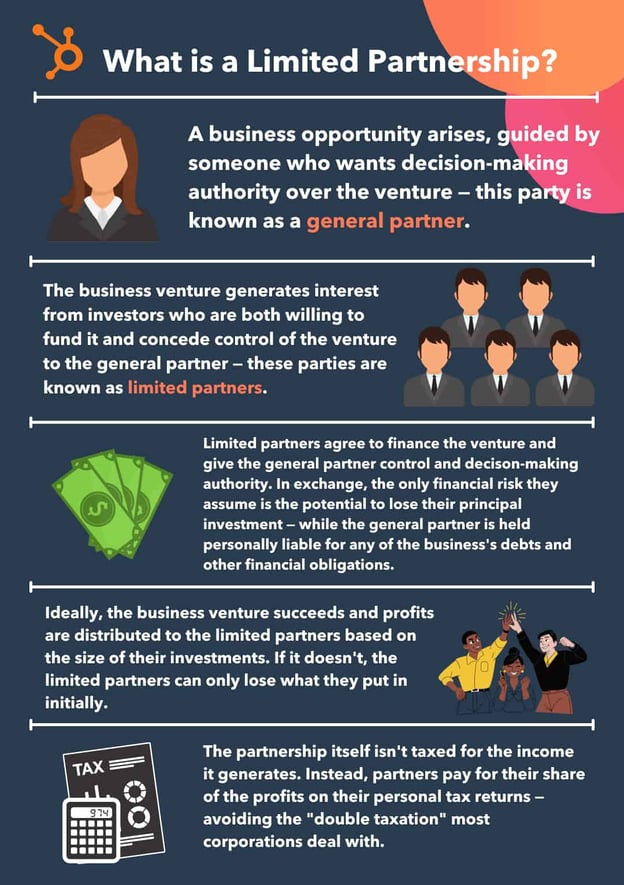A limited partnership is a business model that can connect bold, enterprising entrepreneurs with savvy investors looking to finance lucrative, low-touch business ventures. If you fit either of those bills, thoroughly understanding the concept is in your best interest.
.jpg)
Here, we'll explore the model further, differentiate it from similar business arrangements, review its pros and cons, and go over some prominent examples of what it looks like in practice. Let's dive in.
What is a limited partnership?
Advantages and Disadvantages of a Limited Partnership
General Partnership vs Limited Partnership
Limited Partnership vs Limited Liability Partnership
What is a limited partnership?
A limited partnership is a business ownership model involving a general partner, who takes unlimited liability for a company's obligations, and one or more limited partners — whose liabilities are limited to the size of their investments. Limited partners typically lack direct control of the companies they invest in.
A limited partnership starts with a general partner — a party who starts or pursues a business venture. They spearhead the partnership's operations and wield most of the decision-making authority in the arrangement.
If the general partner's venture is enticing enough, one or more limited partners — financiers who agree to fund a project without assuming primary control over it — fund the endeavor.
A limited partner's risk is generally limited to their principal investment. They don't have the same degree of legal liability as their general partners — who assume responsibility for any business debts or financial obligations.
Ideally, the venture is successful, and a share of the profits is distributed to each limited partner involved — based on the size of their investments. If the project fails, the limited partners only lose what they put in initially.
One of the main draws of a limited partnership is its "pass-through" taxation structure. Instead of the partnership itself being taxed for the income it generates, limited partners are only taxed for their share of the profits on their personal tax returns — avoiding the "double taxation" that several corporate investors have to deal with.

Now that you have a feel for what limited partnerships are, let's take a look at what they might look like.
Limited Partnership Examples
Limited partnerships are typically applied to time-bound projects. Three of the most prominent examples are filmmaking, real estate, and natural resource exploration projects.
Filmmaking
Limited partnerships have a fairly prevalent place in the entertainment industry — specifically when it comes to filmmaking. They're an excellent vehicle for individual filmmakers who need financial support but still want to retain a high degree of creative control over their projects.
In these cases, limited partners provide the necessary capital to fund a film, but they typically don't interfere with the creative process or the filmmaker's day-to-day operations. In turn, the filmmaker is considered a general partner and isn't protected by limited liability.
Real Estate
Limited partnerships are also common in the real estate industry. Groups of investors often pool capital together to invest in development projects, property purchases, or leasing opportunities.
These parties connect with a general partner (typically an experienced property manager, a development firm, or a corporation), trust them with their investments, and assume limited liability — restricted to how much they put in.
Natural Resource Exploration
Natural resource exploration projects — one-time business ventures where parties try to tap certain areas for resources like oil, minerals, and natural gas — are often structured as limited partnerships.
Like filmmaking and real estate development, natural resource exploration projects are typically seen as one-off endeavors. Making them ideal investments for prospective partners looking to assume limited, non-recurring risk for potentially high rewards.
Advantages and Disadvantages of a Limited Partnership
Advantage: There's limited partnership taxation.
Limited partnership taxation is one of the structure's biggest draws. As I mentioned, limited partnerships are unique in that they don't pay direct income taxes. Instead, any financial losses or profits are "passed through" to partners — and partners include those gains or losses on their individual tax returns.
Since a limited partnership itself is exempt from income taxes, partners avoid "double taxation" — a scenario where a corporation pays direct taxes on its business profits, then distributes those profits to shareholders who also pay individual taxes on those gains.
Disadvantage: General partners assume a lot of risk.
General partners involved in limited partnerships are primarily responsible for most aspects of their ventures — and that can be both empowering and unnerving.
As I touched on, general partners have most of the decision-making authority in a limited partnership, but they're also primarily responsible for the partnership's liabilities, debts, and other obligations. That means if a business venture takes an unfortunate turn, their personal assets — in addition to their business assets — are on the line.
Advantage: Limited partners don't assume a lot of risk.
On the flip side of the previous point, the limited partners involved in a limited partnership aren't on the hook for anything after their initial investments. That makes these arrangements a good bet for financiers who are willing to sacrifice control of a business venture in exchange for financial security.
The worst that can happen to a limited partner in a limited partnership is that they don't recoup what they put in initially. While losses like that aren't necessarily trivial, they're essentially fixed and generally manageable.
If a venture goes belly-up, they're not expected to put up any business or personal assets to cover losses and liabilities. That makes limited partnerships lower risk bets for funders.
Disadvantage: Limited partners have very limited sway when it comes to decision-making.
Limited partners are called "limited" for a reason. In exchange for assuming "limited" financial risk, they're "limited" in their ability to guide a business venture.
They're more or less asked to totally trust their general partners with the direction and decision-making behind their investment. In many cases, they also don't have the flexibility to withdraw their funds as the venture progresses without the consent of the general partner.
That can make these arrangements frustrating for some limited partners. If a general partner is lazy, erratic, stubborn, or flat-out ineffective, limited partners often don't have the agency or authority to step in and set them straight.
Advantage: There tends to be a high amount of funding.
Because limited partnerships involve less risk and active involvement, they can often attract a wide range of investors. If limited partners see their potential general partners as capable and committed, they'll likely be inclined to trust them with their money.
And while some potential investors might be put off by the idea of not being actively involved in a venture's direction, many are open to or even enthusiastic about the idea of sitting back and letting their investments work for them. All of that tends to amount to a higher level of funding than there might be with other business models.
Limited partnerships are often conflated with other business models — most notably general partnerships, LLCs, and liability partnerships. Let's take a look at some of the key differences that distinguish limited partnerships from similar arrangements.
General Partnership vs Limited Partnership
The differences between a general partnership and limited partnerships revolve around degrees of personal investment. General partners typically have a much more personal stake in a business — and that trend manifests itself in a couple of ways.
For one, limited partners aren't personally liable for a company's debts and obligations in the same way general partners are. If a company goes into debt, a general partner's personal assets might come into play when paying it off. At worst, a limited partner can only fail to recoup their investment if a business they fund goes belly up.
But that degree of personal liability comes with a tradeoff. Though general partners assume more risk than their limited counterparts, they also have much more immediate control of a company's day-to-day operations.
In most cases, limited partners don't have decision-making authority for the businesses they invest in. And they typically can't withdraw funds — even the principal amount they invested — without permission from the general partner.
Limited Partnership vs. LLC
A limited liability company (LLC) is a corporate structure wherein no owners of a company are held personally liable for a company's debts and obligations. Neither of these entities pays taxes themselves — instead, their losses and profits are passed through their members to be claimed on their individual tax returns.
There are a few key distinctions between a limited partnership and an LLC — the difference in each model's respective ownership structure being one of the most important.
Where a limited partnership has multiple stakeholders that either have complete or no decision-making authority, every stakeholder in an LLC has the right to actively assist in managing the business.
And as I mentioned, LLC members are also all sheltered from personal liability for a company's debts and obligations. If an LLC goes under, the members' personal property won't be in jeopardy like a general partner's in a limited partnership.
Limited Partnership vs Limited Liability Partnership
Limited partnerships are often confused with limited liability partnerships (LLPs) — business arrangements where two or more business partners assume some degree of shared, personal liability for a company's debts and obligations.
The difference between the two has to do with each arrangement's share of liability. With an LLP, everyone involved is on the hook for any legal obligations or repercussions the business might incur — not just a single general partner.
Ultimately, the practicality of forming a limited partnership really varies from case to case. In some instances, it's a no-brainer to entrust a general partner with a business venture while a cast of limited partners supports them with relatively low financial risk. Other times, it makes more sense to make partners more actively involved with a little more skin in the game.
No matter what your business venture might look like, arranging a limited partnership is probably worth some consideration — even if you ultimately wind up landing on a different partnership structure.
Editor's note: This post was originally published in September 2021 and has been updated for comprehensiveness.
Startups


![7 Best Ways to Find Your First Customer & Keep Them [+Resources]](https://2406023.fs1.hubspotusercontent-na1.net/hubfs/2406023/Imported_Blog_Media/how-to-get-first-customer.jpeg)
.jpg)
.jpg)
.jpg)
.jpg)
